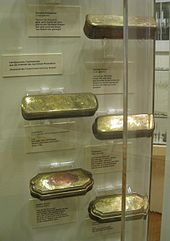Iserlohner tobacco boxes

The Iserlohn tobacco boxes from Iserlohn and the surrounding area were a specialized form of local brass goods production. They reached the height of their importance in the 18th century and especially in the context of Prussian war propaganda during the Seven Years' War .
General
The production of brass products based on regional calamine mining has existed in Iserlohn and the surrounding area since the 17th century . This also includes the manufacture of tobacco boxes. In the beginning, they were guided by models from the Netherlands.
The cans were initially engraved by hand as expensive individual pieces, before the stamping technique with steel matrices prevailed from 1754, which led to the production of larger quantities. This technical innovation led to the still hand-made tobacco boxes from the Netherlands being pushed out of the market. The wall was often made of copper, while the lid was made of brass.
The engraver Johann Heinrich Giese (1716–1761) was one of the first to produce tobacco boxes in this way. Frederick II granted him a monopoly on this in 1755. Later manufacturers can be identified by signatures on the products.
The motifs of the cans were varied. There were cans with biblical scenes, pictures of hunting or social life. Views of cities and much more were imprinted.
Cans for war propaganda
War and battle scenes were depicted, especially during the Seven Years' War. With this, the producers reacted to the previously unusually strong patriotic mood and admiration for Frederick II in Prussia and beyond. Above all, the victories of the Prussians in the various battles were depicted. Remarkably, the production apparently took place largely unhindered despite the Austrian occupation of the county of Mark . The relatively inexpensive cans found massive sales not only in Prussia, but also in the entire north-west of the German Empire as far as the Netherlands. Frederick II gave away tobacco boxes as gifts of honor.
End and aftermath
In the further course of the 18th century the production of tobacco boxes decreased. The last detectable box was made in 1777. The brass industry as such continued to exist. Today Iserlohn tobacco boxes are traded as collector's items. Some examples are exhibited in the Iserlohn City Museum, among others .
Individual evidence
- ↑ cf. for example: Marian Füssel: The Seven Years War. A world war in the 18th century. Munich 2010, p. 93; Christopher Clarke: Prussia. Rise and fall 1600–1947. Bonn 2007, p. 267.
literature
- Ernst Dossmann : Iserlohn tobacco boxes tell a story. Iserlohn 1981
- Wolf Dieter Könenkamp: Iserlohn tobacco boxes . Images of a wartime. Münster 1982.
- Sandra Hertel: A picture of friend and foe. The Iserlohn tobacco tins in the media war between Friedrich II and Maria Theresa. In: The Märker. 67./68. Volume, Lüdenscheid 2019, ISSN 0024-9661 , pp. 81–97
